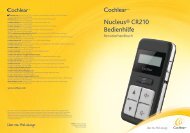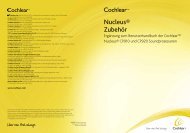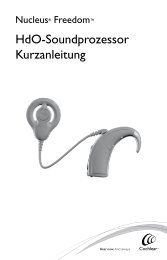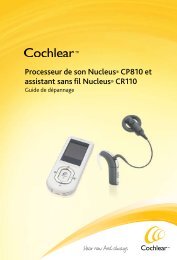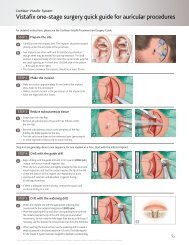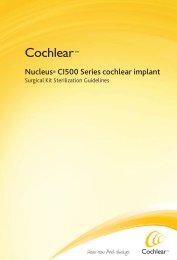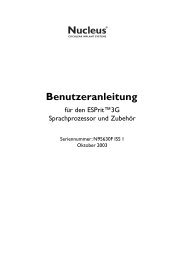Ling 6 Sound Test - Cochlear
Ling 6 Sound Test - Cochlear
Ling 6 Sound Test - Cochlear
You also want an ePaper? Increase the reach of your titles
YUMPU automatically turns print PDFs into web optimized ePapers that Google loves.
LING-6 SOUND TEST<br />
<strong>Ling</strong>-6 <strong>Sound</strong>s daily check<br />
Name:_________________________________________________________<br />
Uses:<br />
q A cochlear implant only<br />
q A hearing aid only<br />
q Both a cochlear implant and a hearing aid<br />
Distance tested at:____________________ Presentation Level: __________________<br />
q Noisy situation OR q Quiet situation<br />
Week of:<br />
Monday<br />
Tuesday<br />
Wednesday<br />
Thursday<br />
Friday<br />
Saturday<br />
Sunday<br />
Week of:<br />
Monday<br />
Tuesday<br />
Wednesday<br />
Thursday<br />
Friday<br />
Saturday<br />
Sunday<br />
Week of:<br />
Monday<br />
Tuesday<br />
Wednesday<br />
Thursday<br />
Friday<br />
Saturday<br />
Sunday<br />
Week of:<br />
Monday<br />
Tuesday<br />
Wednesday<br />
Thursday<br />
Friday<br />
Saturday<br />
Sunday<br />
2010 <strong>Cochlear</strong> Ltd & Cheryl L. Dickson<br />
ah m oo sh s ee<br />
1
LING-6 SOUND TEST<br />
<strong>Ling</strong>-6 <strong>Sound</strong> – How to develop and chart<br />
The <strong>Ling</strong> 6 <strong>Sound</strong>s<br />
The <strong>Ling</strong> 6 sounds represent different speech sounds from low to high pitch (frequency). They help<br />
to test your child’s hearing and to check that they have access to the full range of speech sounds<br />
necessary for learning language.<br />
m a i u sh s<br />
What is the <strong>Ling</strong> 6 sound test?<br />
The <strong>Ling</strong> 6 sound test was developed as a quick and easy test that parents and professionals can use<br />
to check their child’s hearing. The test checks that the child can hear (detection) and in time recognize<br />
each sound (identification) across the different speech frequencies.<br />
The test also checks that the cochlear implant system is working effectively.<br />
Why these 6 sounds?<br />
The <strong>Ling</strong> 6 sounds are the particular sounds that occur at particular speech frequencies.<br />
<strong>Ling</strong> sound Frequency<br />
M / m / is a low frequency sound and if your child cannot hear this sound it is likely they<br />
will not have sufficient low frequency information to develop speech with normal<br />
prosody and without vowel errors.<br />
U / u / has low frequency information.<br />
I / i / has some low and some high frequency information.<br />
A / a / is at the centre of the speech range.<br />
Sh / sh / is in the moderately high frequency speech range.<br />
S / s / is in the very high frequency speech range.<br />
Table 1 shows the <strong>Ling</strong> 6 sounds,<br />
along with other speech sounds,<br />
plotted on an audiogram This<br />
shows both the frequency and<br />
the loudness of each sound. We<br />
suggest talking with your hearing<br />
health professional for a full<br />
explanation and interpretation of<br />
this audiogram.<br />
2010 <strong>Cochlear</strong> Ltd & Cheryl L. Dickson<br />
2
LING-6 SOUND TEST<br />
<strong>Ling</strong>-6 <strong>Sound</strong> – How to develop and chart<br />
How to give the test<br />
Present each sound individually and randomly to ensure that your child is not predicting or guessing the sound<br />
by the order in which they are presented.<br />
Initially say the sound at a distance of 20cm from the child’s microphone. Make sure that the environment is<br />
quiet and calm.<br />
Once the child is consistently responding at that distance, increase it to 1meter, then 2meter, then 3 meters.<br />
2m is the typical distance for conversation between 2 people.<br />
3m is the typical distance for conversation between more than 2 people.<br />
Use a normal speaking voice, and sit beside or behind the child to ensure a hearing only response. When the<br />
child responds ( smile, turn, stilling ) give them positive reinforcement. (‘You heard that!! …Good listening!’)<br />
If the child does not respond to a sound, try saying the sound again with some intonation and longer. If your<br />
child does not respond the second time, move on to another sound. Make a note on the 6 sound chart and<br />
discuss with your audiologist and therapist.<br />
Use the daily check form<br />
Record your child’s information at the top of each monthly check form. This includes their name, their listening<br />
device (CI, HA, CI+HA, or 2CI), the distance and the listening situation.<br />
Use the following symbols to show the child’s response.<br />
4 = correct response − = no response<br />
If your child says the wrong sound, record what the child said. Also if repetition was required.<br />
Reference:<br />
nd 1. <strong>Ling</strong>.D. (2002) Speech and the Hearing Impaired Child (2 ed.) Washington, DC: A.G. Bell Association for the Deaf and Hard of Hearing.<br />
2010 <strong>Cochlear</strong> Ltd & Cheryl L. Dickson<br />
3



